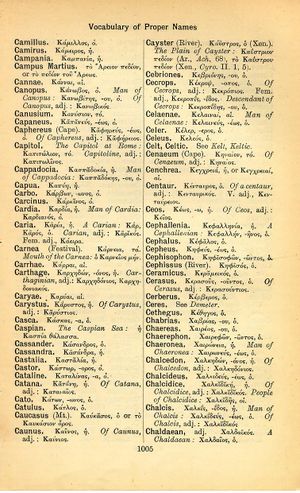Cannae: Difference between revisions
δειναὶ δ' ἅμ' ἕπονται κῆρες ἀναπλάκητοι → and after him come dread spirits of death that never miss their mark
(Names) |
(6_3) |
||
| Line 1: | Line 1: | ||
{{WoodhouseENELnames | {{WoodhouseENELnames | ||
|Text=[[File:woodhouse_1005.jpg|thumb|link={{filepath:woodhouse_1005.jpg}}]]Κάνναι, αἱ. | |Text=[[File:woodhouse_1005.jpg|thumb|link={{filepath:woodhouse_1005.jpg}}]]Κάνναι, αἱ. | ||
}} | |||
{{Lewis | |||
|lshtext=<b>Cannae</b>: ārum, f., = Κάνναι (Κάννα, Polyb.),<br /><b>I</b> a [[village]] in [[Apulia]], [[north]] of [[Canusium]], [[famous]] for the [[victory]] of [[Hannibal]] [[over]] the Romans; it [[lay]] on the [[east]] [[side]] of the [[Aufidus]] ([[which]] is [[hence]] called Amnis Canna by [[Marcius]] [[vates]] ap. Liv. 25, 12, 5), [[now]] Canne, id. 22, 44, 1 sq. (Polyb. 3, 113); Flor. 2, 6, 15; Cic. Tusc. 1, 37, 89: Cannarum [[pugna]], Liv. 23, 43, 4; Sil. 9, 10.—Appellative: Capuam Hannibali Cannas fuisse, a [[second]] Cannœ, Liv. 23, 45, 4; Flor. 2, 6, 21. —<br /><b>II</b> Deriv.: Cannensis, e, adj., of Cannœ, Cannensian: [[pugna]], Liv. 23, 1, 1; 23, 1, 11; Prop. 3 (4), 3, 10 al.: [[acies]], Liv. 23, 18, 13: [[calamitas]], Cic. Brut. 3, 12: [[clades]], Liv. 22, 50, 1; 25, 12, 5; 23, 30, 11: [[ruina]], id. 23, 25, 3: [[dies]], Flor. 4, 12, 35: [[exercitus]], [[which]] [[was]] [[cut]] to pieces at Cannœ, Liv. 29, 24, 11: animae, of those [[who]] [[fell]] at Cannœ, Stat. S. 1, 4, 87.—Appel., of the [[proscription]] of [[Sulla]]: te [[pugna]] Cannensis accusatorem sat [[bonum]] fecit, Cic. Rosc. Am. 32, 89; and of a [[revel]]: Cannensis [[pugna]] nequitiae, id. Verr. 2, 5, 11, § 28; cf. Arn. 5, 38. —As subst.: Cannenses, ium, m., the inhabitants of Cannœ, Plin. 3, 11, 16, § 105. | |||
}} | }} | ||
Revision as of 08:24, 13 August 2017
English > Greek (Woodhouse)
Κάνναι, αἱ.
Latin > English (Lewis & Short)
Cannae: ārum, f., = Κάνναι (Κάννα, Polyb.),
I a village in Apulia, north of Canusium, famous for the victory of Hannibal over the Romans; it lay on the east side of the Aufidus (which is hence called Amnis Canna by Marcius vates ap. Liv. 25, 12, 5), now Canne, id. 22, 44, 1 sq. (Polyb. 3, 113); Flor. 2, 6, 15; Cic. Tusc. 1, 37, 89: Cannarum pugna, Liv. 23, 43, 4; Sil. 9, 10.—Appellative: Capuam Hannibali Cannas fuisse, a second Cannœ, Liv. 23, 45, 4; Flor. 2, 6, 21. —
II Deriv.: Cannensis, e, adj., of Cannœ, Cannensian: pugna, Liv. 23, 1, 1; 23, 1, 11; Prop. 3 (4), 3, 10 al.: acies, Liv. 23, 18, 13: calamitas, Cic. Brut. 3, 12: clades, Liv. 22, 50, 1; 25, 12, 5; 23, 30, 11: ruina, id. 23, 25, 3: dies, Flor. 4, 12, 35: exercitus, which was cut to pieces at Cannœ, Liv. 29, 24, 11: animae, of those who fell at Cannœ, Stat. S. 1, 4, 87.—Appel., of the proscription of Sulla: te pugna Cannensis accusatorem sat bonum fecit, Cic. Rosc. Am. 32, 89; and of a revel: Cannensis pugna nequitiae, id. Verr. 2, 5, 11, § 28; cf. Arn. 5, 38. —As subst.: Cannenses, ium, m., the inhabitants of Cannœ, Plin. 3, 11, 16, § 105.

